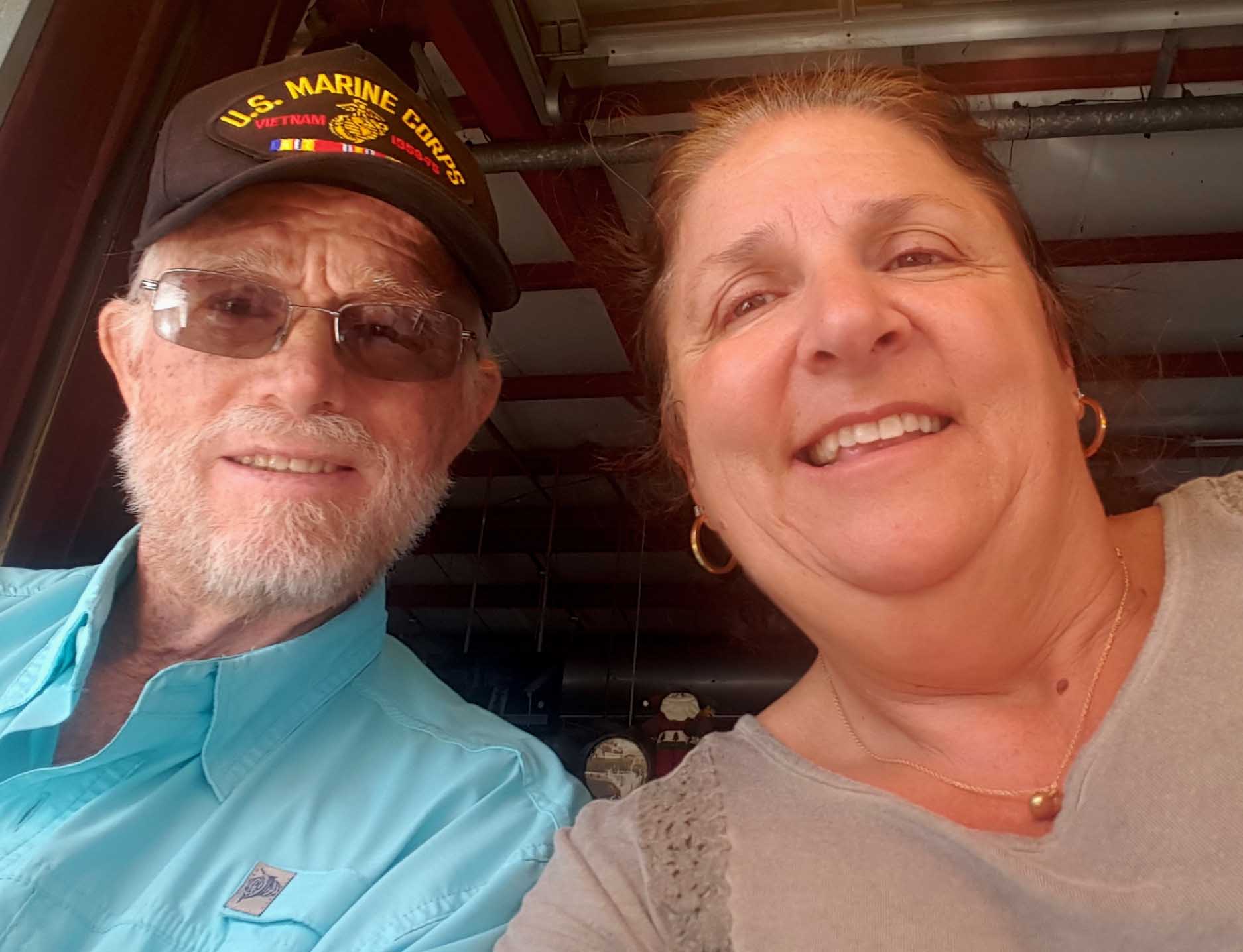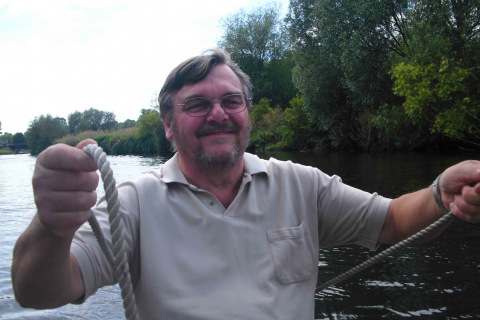Mesothelioma Survivor Credits Moffitt’s Chemoperfusion Study

Fact Checked | Written by: Tim Povtak | Last Update: 10/25/2024 | 7 Min Read
Russell Lamkins is in a race against time, hoping to finish the extensive renovation of his waterfront home in southwest Florida before pleural mesothelioma closes the door.
He likes his chances of winning.
Lamkins, who was diagnosed in August 2014, is becoming a beacon of hope with his early success in the transarterial chemoperfusion study at the Moffitt Cancer Center in Tampa.
After standard-of-care treatment and immunotherapy failed him, Lamkins turned to Dr. Bela Kis, a noted interventional radiologist who opened this novel clinical trial.
Almost immediately, his tumors stopped growing. Then they started shrinking. This started 11 months ago.
“When I was first diagnosed with stage III inoperable cancer and told I had a year to live, I figured I’d better hurry up and try to finish this house quickly,” Lamkins told Asbestos.com from his home in Bonita Springs. “But now, things have changed. My goal is to make it to the 10-year mark. It might take me that long to finish this job. I don’t move very fast anymore.”
Retired Construction Worker Stays Busy
Lamkins, 70, spent his working years in the construction industry. He and his wife, Sandi, bought the home in 2012, providing the major do-it-yourself project he wanted for retirement.
He lays the tiles, hammers the nails, drills the screws and installs every piece — modernizing the home one room at a time. He tears out floors and tears down walls.
There is even talk now about an addition.
“My neighbors don’t even know I’m sick. I still look and feel pretty good, although I’ve lost muscle tone,” he said. “I just don’t like sitting around watching TV. It gets old real fast. I’m the type I have to be doing something. I was just on the roof the other day. There’s a lot to do around here. We’ve got a busy schedule.”
Fontaine Heads the Mesothelioma Program
Moffitt’s Mesothelioma Treatment & Research Institute, led by thoracic surgeon Dr. Jacques Fontaine, sparked Lamkins’ comeback.
A year ago, his options were scarce. His cancer was inoperable. The mesothelioma was growing. And the immunotherapy drug wasn’t working.
He was headed toward hospice.
“We heard about this study, and I asked my local oncologist here. He wasn’t offering much. He said, if you want to be a guinea pig, go do it, that’s your choice,” Lamkins recalled. “Well, I really had no choice. I had nothing to lose, and figured if it didn’t work for me, what the doctors learned might help somebody else down the road.”

Gain access to top mesothelioma doctors and get help scheduling appointments.
Connect NowNovel Treatment Targets Tumors
The aortic chemoperfusion therapy involves identifying specific blood vessels that feed the tumors and delivering high-dose chemotherapy directly to them.
Specifically targeting the tumors allows for a higher concentration of chemotherapy, but it avoids much of the debilitating side effects of traditional systemic delivery because it minimizes exposure to the rest of the body.
“It’s technically challenging,” Kis told Asbestos.com. “But it’s my expertise. It’s a relatively easy procedure. We’ve been very pleased with what we’ve seen so far.”
A similar chemoperfusion strategy worked well at a few specialty centers for liver cancer.
Moffitt is the first cancer center in the U.S. to use the therapy for mesothelioma. It worked for pleural mesothelioma in Germany and Egypt, where it extended survival and created a better quality of life for patients.
Kis also changed the chemotherapy mix, believing it will work more effectively than what is used in Europe. He uses a cisplatin, gemcitabine and methotrexate mix.
Only a handful of patients are enrolled in the study so far. It originally was designed as a second-line therapy, after a patient has stopped responding to traditional treatment.
Lamkins’ success may be changing the protocol.
“This has been very exciting for everyone,” Kis said. “We weren’t sure what to expect in terms of side effects, but there have been very few. And technologically, we’re over the learning curve.”
Aortic Chemoperfusion Therapy Produces Few Side Effects
The procedure is minimally invasive. Lamkins usually leaves a few hours after arriving at Moffitt, although his wife drives home.
They often arrive the night before in their 34-foot motor home, which they bought two years ago to travel the country.
“She drives after my treatment, but I heard her tell somebody, only because she has duct tape and rope in the front seat to stop me from second guessing her,” he said. “For a couple days after treatment, I’m a little wiped out, but it’s not that bad.”
Lamkins receives the treatment every four or five weeks, often adjusted for his personal schedule. Since buying the motor home, he and his wife travel considerably.
They spent December fishing in the Florida Keys with other family members. They took the motor home to Atlanta to visit his daughter and drove last summer to Wisconsin, where Lamkins grew up on a farm and where his son and other family members still live.
A trip to visit Sandi’s family in the Azores, near Portugal, is planned for later this. Lamkins is talking about a cross-country trip this summer through Texas, Nevada and Northern California, possibly flying home to Tampa and back for treatment.

Eating the right diet throughout mesothelioma treatment can ease your symptoms.
Get Free Recipes and TipsLiving a Healthy and Active Lifestyle
Lamkins took Sandi and her mother out to dinner on Valentine’s Day.
He is talking about joining a nearby fitness center to improve his muscle tone.
Lamkins served in the U.S. Marine Corps during the Vietnam War and doesn’t weigh much more today than he did 50 years ago.
He lives a healthy lifestyle thanks to his wife, who brings home only organic food with very little sugar. His mother also lived to be 101.
“I cough a little bit, and don’t have the stamina I once did, but part of that is just old age,” he said. “Otherwise I’m doing pretty well. I think the doctors like having me in the study.”
Finishing the Clinical Trial and the House
Lamkins is a firm believer in what Moffitt is doing with the clinical trial, providing researchers with new information about mesothelioma treatment.
He also knows the history of this cancer with no definitive cure.
“If they didn’t have guinea pigs like me, they’d never learn anything for the future,” he said. “I also know this won’t last forever. If I get to the point where I can’t walk and I’m doing nothing but coughing, then I’ll just go jump in the water. You have to know when to call it quits, and I will. My brother-in-law who is really sick stopped his treatment, and he says he feels better dying than he did fighting to stay alive.”
Until he and Sandi leave for the Azores, though, Lamkins will spend much of his time working at the house.
He is adding new siding and reinforced windows and doors to protect against storms.
“My goal is to be the longest living male survivor [of mesothelioma],” he said. “And it might take me that long to finish this house. I might even have the bathroom done by then.”





